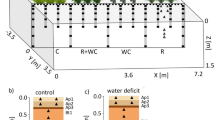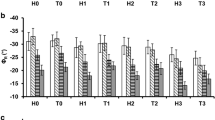Abstract
The paper concerns influence of water distribution on the bioelectric potential in the soil–plant system. Two methods for measuring bioelectric potentials (BEPs) of plants have been compared, namely an invasive installation of needle electrodes (a) and a noninvasive method of providing contact due to root intergrowth through a metal grid (b). It has been shown that needle electrode installation into plant tissue leads to a decrease in the biopotential difference from 70 mV to a noise level within ~ 30 minutes; in fact, this means measuring the potentials generated by the plant organism due to the stress caused by the damage. On the contrary, noninvasive electrode installation provides long-term measurements for months and even longer. A specific system is suggested for automated electrophytogram based on the noninvasive method. It allows one long-term measurement of the plant electrophysiological signal directly under normal living conditions for the rhizosphere; it indicates the current functional state of a plant. An equivalent BEP measurement scheme has been proposed accounting for both electrical properties of the plant and root–inhabited medium. BEPs have been measured under conditions of varying water content in the root zone and water movement along and against the root growth direction. The biopotential is constant on average and fluctuates stochastically in the range from 245 to 275 mV at 60–70% of the total water capacity of the soil substrate. The bioelectric potential decreases almost twice when the soil dries. It is restored after irrigation and the restoration delay time increases with increasing water-deficit period. A model is proposed describing the effects in the system during a water-deficiency regime and irrigation.



Similar content being viewed by others
REFERENCES
E. V. Burlakova, B. N. Veprintsev, O. R. Kol’s, and Yu. A. Kriger, Practical Manual on General Biophysics, Nos. 3–4: Bioelectric Phenomena in Tissues and Cells (Vysshaya Shkola, Moscow, 1961) [in Russian].
V. A. Vodeneev, O. N. Sherstneva, L. M. Surova, M. M. Semina, L. A. Katicheva, and V. S. Sukhov, “Age-dependent changes of photosynthetic responses induced by electrical signals in wheat seedlings,” Russ. J. Plant Physiol. 63, 861–868 (2016). https://doi.org/10.1134/S1021443716050162
R. A. Kolovskii, Bioelectric Potentials in Wood Plants (Nauka, Novosibirsk, 1980) [in Russian].
T. E. Kuleshova, A. V. Bushlyakova, and N. R. Gall’, “Noninvasive measurement of bioelectric potentials of plants,” Tech. Phys. Lett. 45, 190–192 (2019).
T. E. Kuleshova, A. I. Likhachev, E. S. Pavlova, D. O. Kuleshov, A. V. Nashchekin, and N. R. Gall, “Interrelation of absorption spectra of plant pigments and LED lighting with different spectral compositions,” Tech. Phys. 63, 1243–1247 (2018).
M. A. Kutimskaya, M. Yu. Buzunova, and L. V. Ubryatova, “Bioelectrogenesis and information exchange in higher plants including cereals,” Vestn. Irkutsk. Gos. S-kh. Akad., No. 60, 105–110 (2014).
S. S. Medvedev, Plant Physiology: Manual (BKhV-Peterburg, St. Petersburg, 2012) [in Russian].
V. A. Opritov, “Electricity in animal and plant life,” Sorosovskii Obraz. Zh., No. 9, 40–46 (1996).
Yu. N. Orlov and O. N. Suglobova, Analysis of Characteristics of Bioelectric Electrodes (Bauman Moscow State Technical Univ., Moscow, 2008) [in Russian].
A. P. Pasichnyi and V. G. Karmanov, “Non-contact measurement of the bioelectric potential of the leaves of higher plants,” in Experimental Biophysics and Cybernetics of Plants (Gidrometeoizdat, Leningrad, 1969), No. 24, pp. 161–168.
A. I. Pozdnyakov, “Bioelectric potentials in the soil-plant system,” Eurasian Soil Sci. 46, 742–750 (2013).
A. I. Pozdnyakov, L. A. Pozdnyakova, and A. D. Pozdnyakova, Stationary Electric Fields in Soils (KMK, Moscow, 1996) [in Russian].
S. S. Pyatygin, “Propagated electrical signals in plants,” Tsitologiya 50 (2), 154–159 (2008).
E. D. Brenner, R. Stahlberg, S. Mancuso, J. Vivanco, F. Baluška, and E. van Volkenburgh, “Plant neurobiology: an integrated view of plant signaling,” Trends Plant Sci. 11 (8), 413–419 (2006). https://doi.org/10.1016/j.tplants.2006.06.009
J. Fromm and S. Lautner, “Electrical signals and their physiological significance in plants,” Plant, Cell Environ. 30 (3), 249–257 (2007). https://doi.org/10.1111/j.1365-3040.2006.01614.x
Y. Hasegawa, R. Hoshino, and H. Uchida, “Development of cultivation environment control system using plant bioelectric potential,” in Proceedings of the 2015 International Symposium on Nonlinear Theory and its Applications (NOLTA2015), Kowloon (Hong Kong, 2015), pp. 860–863.
L. Karlsson, “Instrumentation for measuring bioelectrical signals in plants,” Rev. Sci. Instrum. 43 (3), 458–464 (1972). https://doi.org/10.1063/1.1685661
F. Murohashi, H. Uchida, and Y. Hasegawa, “Evaluation of photosynthetic activity by bioelectric potential for optimizing wavelength ratio of plant cultivation light,” Int. J. Biosens. Bioelectron. 4 (6), 281–287 (2018). https://doi.org/10.15406/ijbsbe.2018.04.00141
T. Ochiai, S. Tago, M. Hayashi, and A. Fujishima, “Highly sensitive measurement of bioelectric potentials by boron-doped diamond electrodes for plant monitoring,” ECS Trans. 75 (16), 233–242 (2016). https://doi.org/10.1149/07516.0233ecst
K. J. Parkinson, PhD Thesis (Durham University, Durham, 1963).
T. A. Tattar and R. O. Blanchard, “Electrophysiological research in plant pathology,” Ann. Rev. Phytopathol. 14 (1), 309–325 (1976).
S. E. B. Tyler, “Nature’s electric potential: a systematic review of the role of bioelectricity in wound healing and regenerative processes in animals, humans, and plants,” Front. Physiol. 8, 627 (2017). https://doi.org/10.3389/fphys.2017.00627
Author information
Authors and Affiliations
Corresponding author
Ethics declarations
The authors declare that they have no conflict of interest.
Additional information
Translated by V. Klyueva
Rights and permissions
About this article
Cite this article
Kuleshova, T.E., Gall, N.R. Dynamics of Bioelectric Potential in the Root Zone of Plants during Irrigation. Eurasian Soil Sc. 54, 381–388 (2021). https://doi.org/10.1134/S106422932103008X
Received:
Revised:
Accepted:
Published:
Issue Date:
DOI: https://doi.org/10.1134/S106422932103008X




